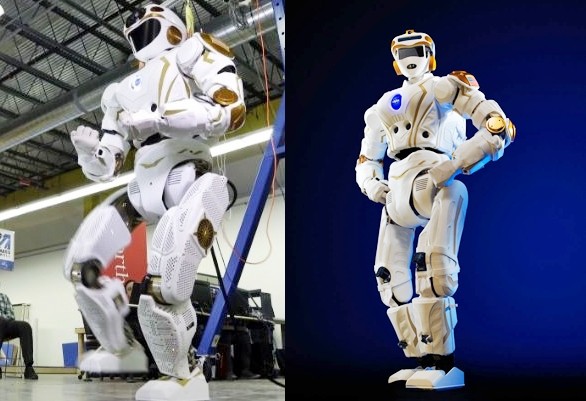‘Female’ Humanoid Valkyrie Robot will be the First to Land on Mars
| Arthur Dominic Villasanta | | May 19, 2016 04:29 AM EDT |
(Photo : NASA) Val, the Martian robot, as she looks today. (Right) Val as she looked in 2013. Note her "lips."
The honor of being the first extraterrestrial to set foot on Mars in 2035 won't go to a human being after all. Rather, it might go to a female humanoid robot made by human beings, both female and male.
Welcome "Val," or the Valkyrie R5 Space Robot, one of four NASA robots whose future iterations will land on Mars to build the habitats and structures needed by frail human beings to survive on the hostile environment pervading the Red Planet. These females will pave the way for the human colonization of Mars.
Like Us on Facebook
Val is a "she humanoid" ( or a "hermanoid'?) seeing she was named after the mythical Norse female deities that brought the souls of selected warriors slain in battle to Valhalla. If you look at one of her early photos from 2013, you can discern Val's "lips" are clearly female.
Apart from that, Val then and now has a glowing NASA logo embedded in her chest that sort of reminds you of Iron Man. But this "she robot" has a lot of muscles for a female, attributes she'll need to build things using tools or drive a Mars Rover.
Val was introduced by NASA to the world in December 2013 as an entry to the DARPA Robotics Challenge Trials. She was originally designed by NASA for disaster-relief and was billed as a "superhero robot." Back then, she stood 1.9 meters tall and weighed 125 kilograms.
The 2016 version of Val has 28 torque-controlled joints and nearly 200 sensors. Engineering students from the University of Massachusetts-Lowell and Northeastern University are involved in a two-year project to improve Val's software and test her ability to manipulate tools, climb a ladder and perform high-level tasks.
The version of Val that does land on Mars will be an entirely different beast altogether. For one, she'll be a lot smarter since she has to use her artificial intelligence (AI) to act on her own and make decisions independent of her human controllers. It takes 20 minutes for commands sent from Earth to reach Mars and that time lag won't do for a humanoid that has to make decisions like a human being.
"It needs to be able to communicate back to Earth, very clearly and concisely, what's going on," said Holly Yanco, a computer science professor who directs UMass-Lowell's robotics center and is an expert on human-robot interactions.
And, let's hope the Val that first lands on Mars will still be a she so she can proudly proclaim, "That's one small step for women; one giant leap for womankind."
TagsVal, Valkyrie R5 Space Robot, NASA, Mars, 2035, Humanoid, Humanoid Robot
©2015 Chinatopix All rights reserved. Do not reproduce without permission
EDITOR'S PICKS
-

Did the Trump administration just announce plans for a trade war with ‘hostile’ China and Russia?
-

US Senate passes Taiwan travel bill slammed by China
-

As Yan Sihong’s family grieves, here are other Chinese students who went missing abroad. Some have never been found
-

Beijing blasts Western critics who ‘smear China’ with the term sharp power
-

China Envoy Seeks to Defuse Tensions With U.S. as a Trade War Brews
-

Singapore's Deputy PM Provides Bitcoin Vote of Confidence Amid China's Blanket Bans
-

China warns investors over risks in overseas virtual currency trading
-

Chinese government most trustworthy: survey
-

Kashima Antlers On Course For Back-To-Back Titles
MOST POPULAR
LATEST NEWS
Zhou Yongkang: China's Former Security Chief Sentenced to Life in Prison

China's former Chief of the Ministry of Public Security, Zhou Yongkang, has been given a life sentence after he was found guilty of abusing his office, bribery and deliberately ... Full Article
TRENDING STORY

China Pork Prices Expected to Stabilize As The Supplies Recover

Elephone P9000 Smartphone is now on Sale on Amazon India

There's a Big Chance Cliffhangers Won't Still Be Resolved When Grey's Anatomy Season 13 Returns

Supreme Court Ruled on Samsung vs Apple Dispute for Patent Infringement

Microsoft Surface Pro 5 Rumors and Release Date: What is the Latest?















